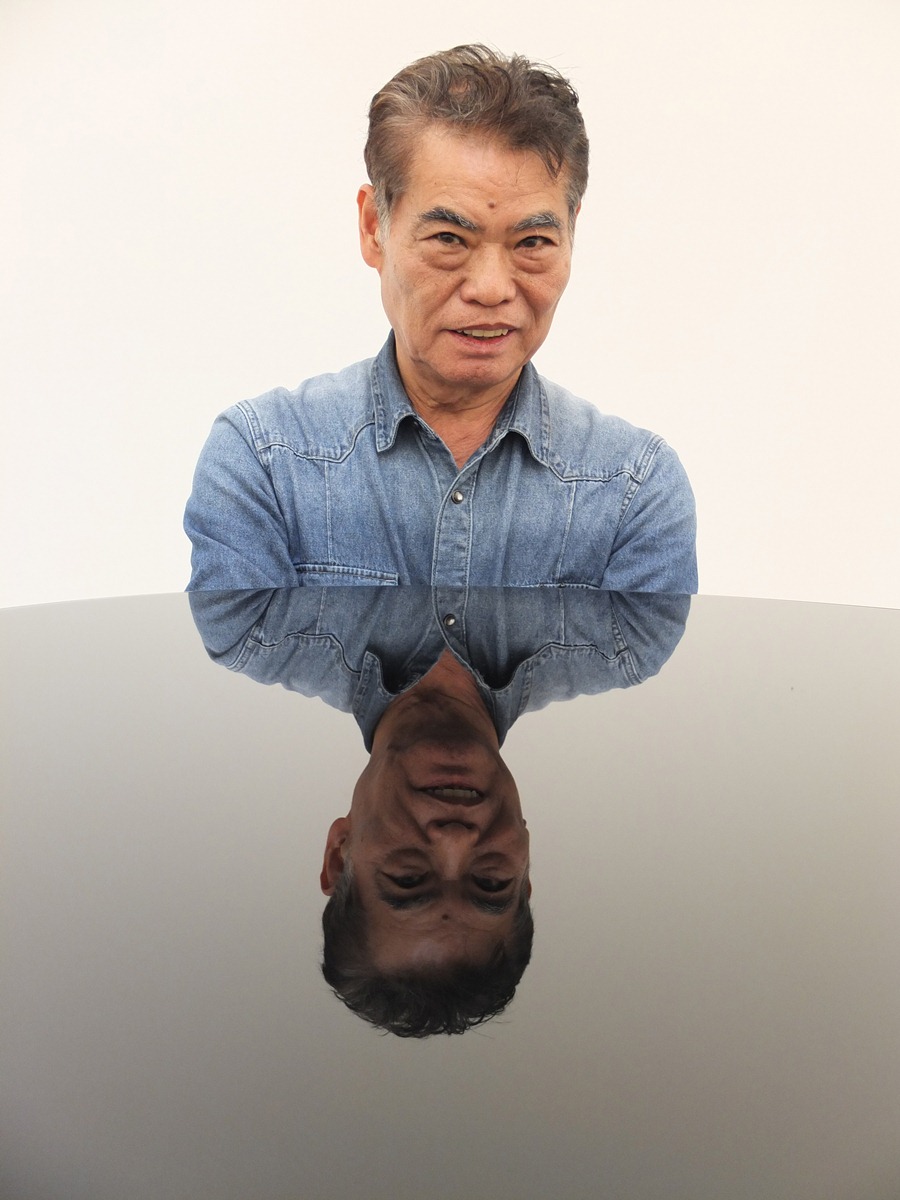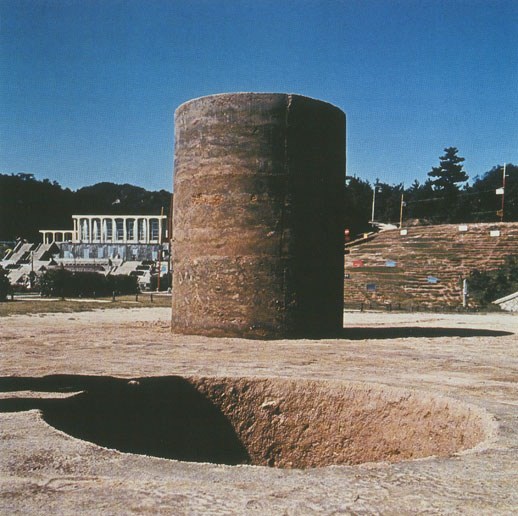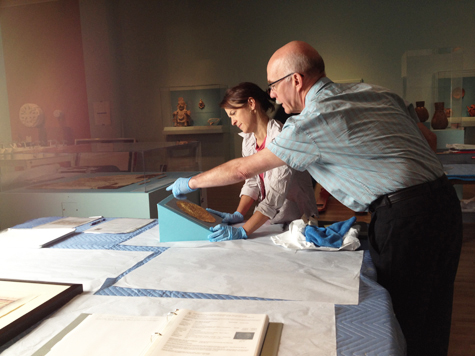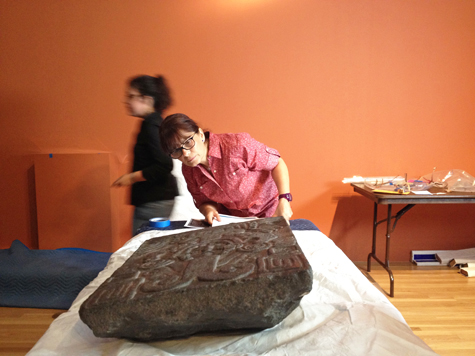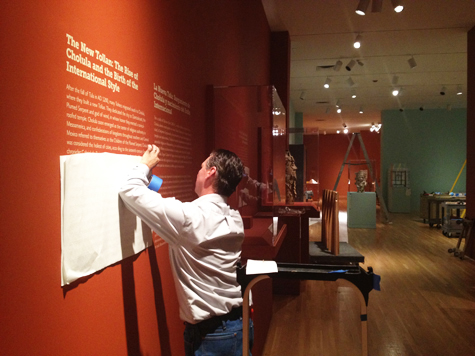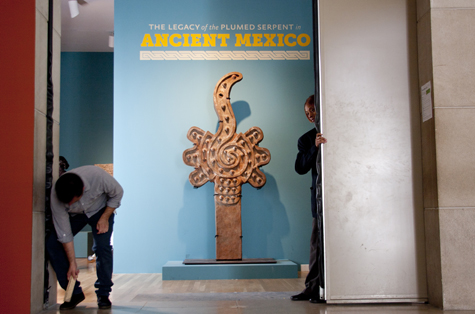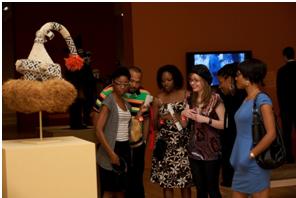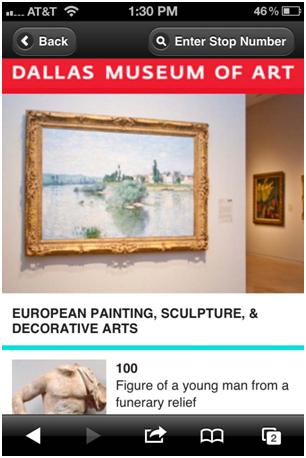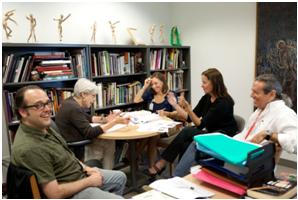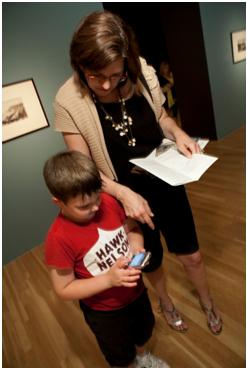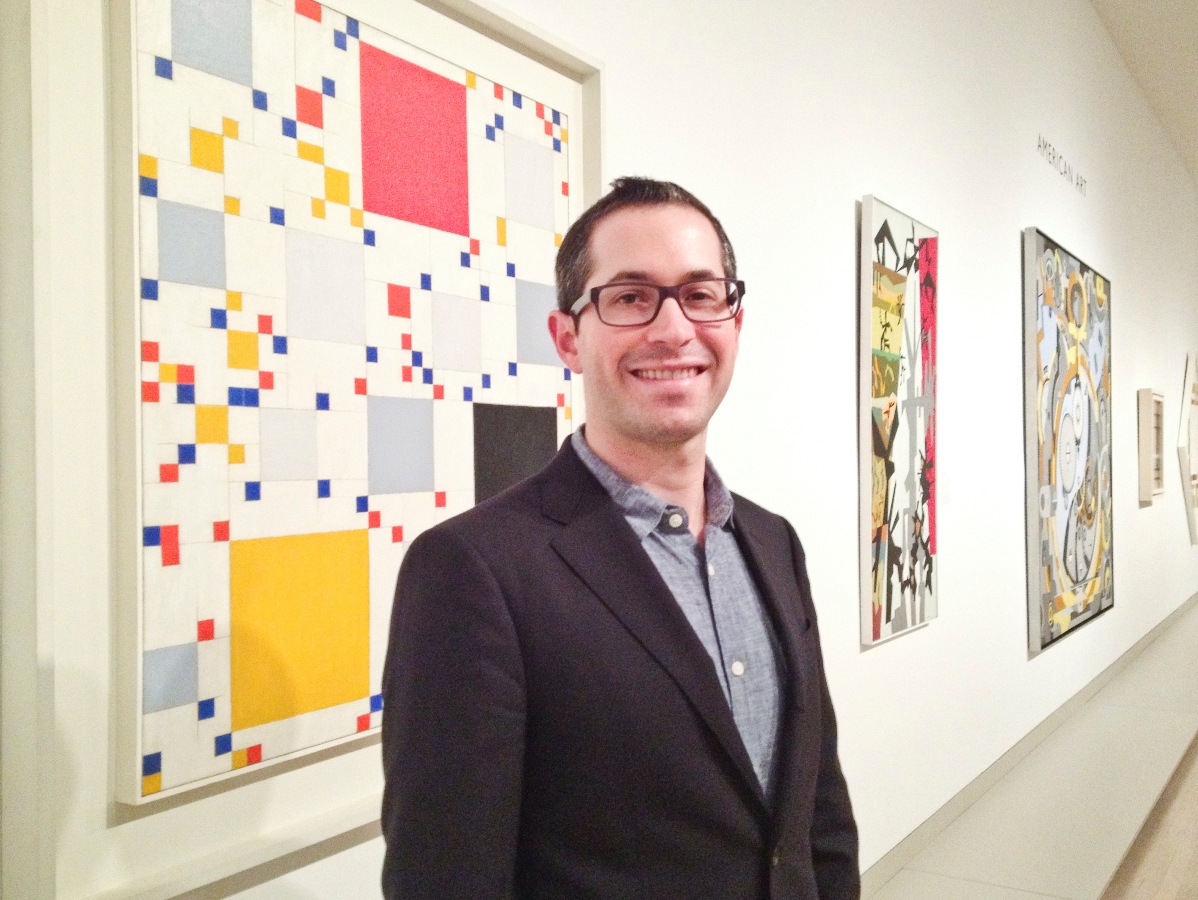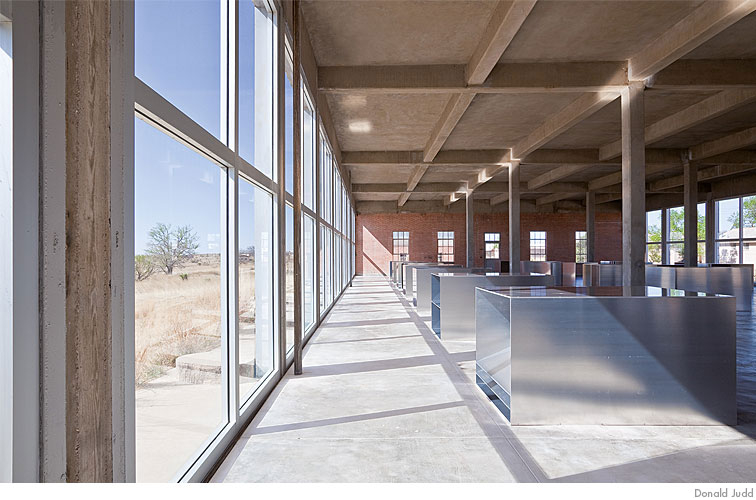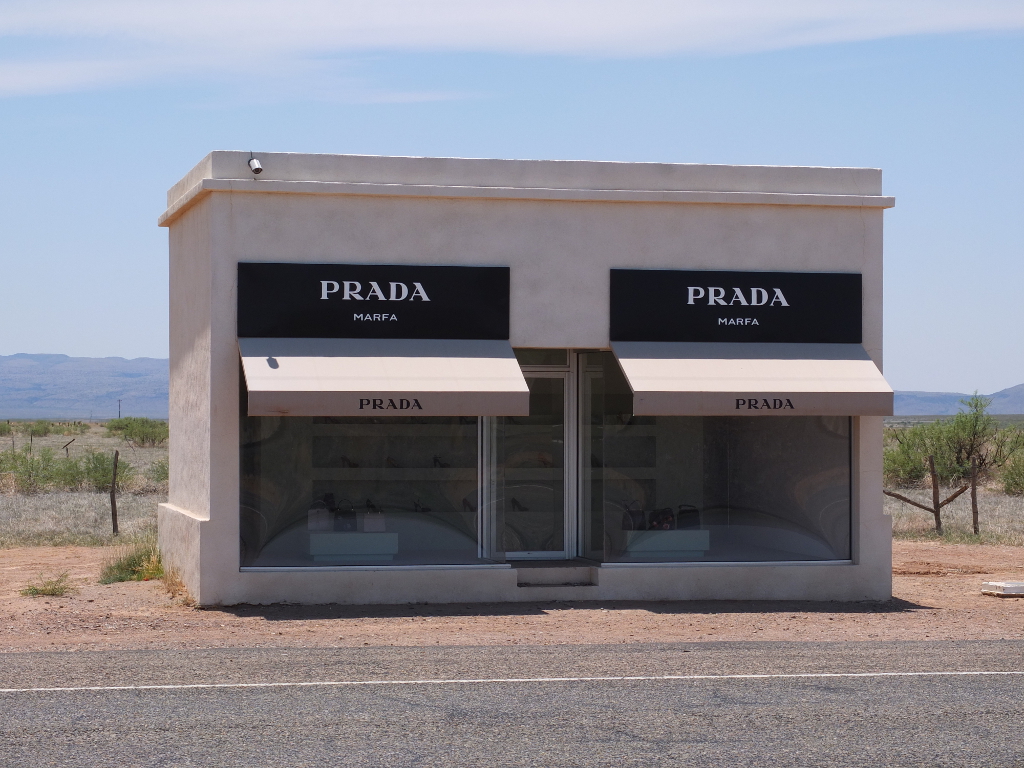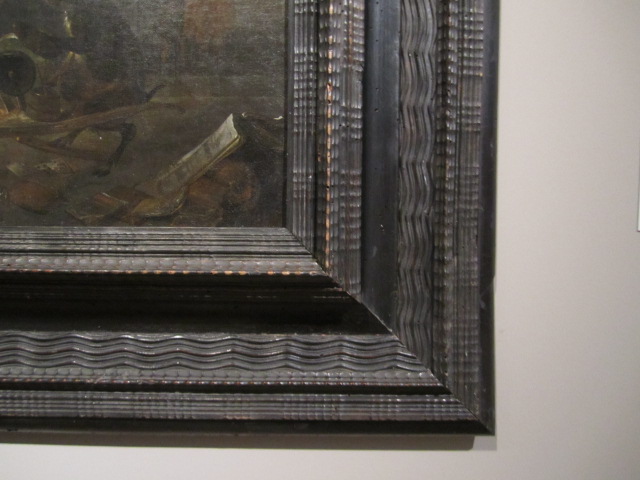Each year we welcome a new group of McDermott interns working in the curatorial and education departments. The 2012-2013 group started at the beginning of the month and include Emily Brown, Emily Schiller, Alex Vargo, Andrea Lesovsky, Alec Unkovic, Hannah Fullgraf, Pilar Wong, and Danielle Schulz. You will hear from each of the interns on Uncrated throughout their nine months at the DMA. Learn more about the McDermott Internships on the DMA’s website; you can apply for your chance to be a 2013-2014 McDermott intern in January.
Archive for the 'Curatorial' Category
Meet the 2012-2013 McDermott Interns
Published September 17, 2012 Curatorial , Education ClosedTags: Dallas Museum of Art, internship, McDermott Internship program
Focus on: Nobuo Sekine
Published August 22, 2012 Collections , Contemporary Art , Curatorial , Exhibitions 2 CommentsTags: Dallas Museum of Art, Donald Judd, Japanese art, Michael Heitzer, Mono-ha, Richard Serra, Robert Morris, Robert Smithson, Sekine Nobuo
 For the past few months, Japanese sculptor Nobuo Sekine’s (b. 1942) works have been on view in the Marguerite and Robert Hoffman Galleries. For those of you who haven’t seen them yet, or are still wondering what these works are all about, this blog post is for you.
For the past few months, Japanese sculptor Nobuo Sekine’s (b. 1942) works have been on view in the Marguerite and Robert Hoffman Galleries. For those of you who haven’t seen them yet, or are still wondering what these works are all about, this blog post is for you.
Phase No. 10 (1968), Phase of Nothingness-Water (1969/2005), and Phase of Nothingness-Cloth and Stone (1970/1994) were originally created in the late 1960s, and what they have in common is the word “phase” in their title. In order to understand these works better, let’s first talk briefly about global art trends in the late 1960s and then explore the idea of “phase” that so interested Sekine.
In the early 1960s, artists such as Richard Serra, Donald Judd, and Robert Morris made a clear shift away from the gestural quality of abstract expressionism (Jackson Pollock) and embraced a more minimal aesthetic. Minimalist art was intended to discard the emotionality of the past along with all non-essential formal elements related to the art object. The resulting work took shape as hard-edge geometric volumes created with industrial materials that showed little-to-no evidence of the artist’s hand in its making. As minimal sculpture evolved, artists in the late 1960s began moving outside the white cube of the gallery and museum space to create large-scale outdoor works that used the earth itself as the medium. Known as Land Art, this movement was closely associated with the work of Robert Smithson, Michael Heitzer, and others. It is within this transitional moment between minimalism and Land Art that the work of Sekine Nobuo and the Mono-ha movement in Japan came into being.
The term Mono-ha (meaning “School of Things”) encompassed a variety of different forms and approaches, but at its core the short-lived movement explored the encounter between natural and industrial objects. Using natural materials such as stone, wood, and cotton in their unadulterated states, in conjunction with wire, light bulbs, glass, and steel plates, the work of Mono-ha artists presented objects “just as they are,” with the hope of bridging the gap between the human mind and the material world.
The tenets of Mono-ha are most clearly embodied in Nobuo Sekine’s famous outdoor sculpture Phase Mother Earth (1968/2012). Often cited as the beginning of the Mono-ha movement, Sekine’s sculpture consists of a 2.2 meter-tall cylinder of earth positioned beside a hole of the exact same dimensions. While clearly in dialogue with other American and European Land Art of the time, the modest scale of Sekine’s work invites the viewer to experience the earth simply as earth rather than as a grand artistic gesture writ large across the landscape.
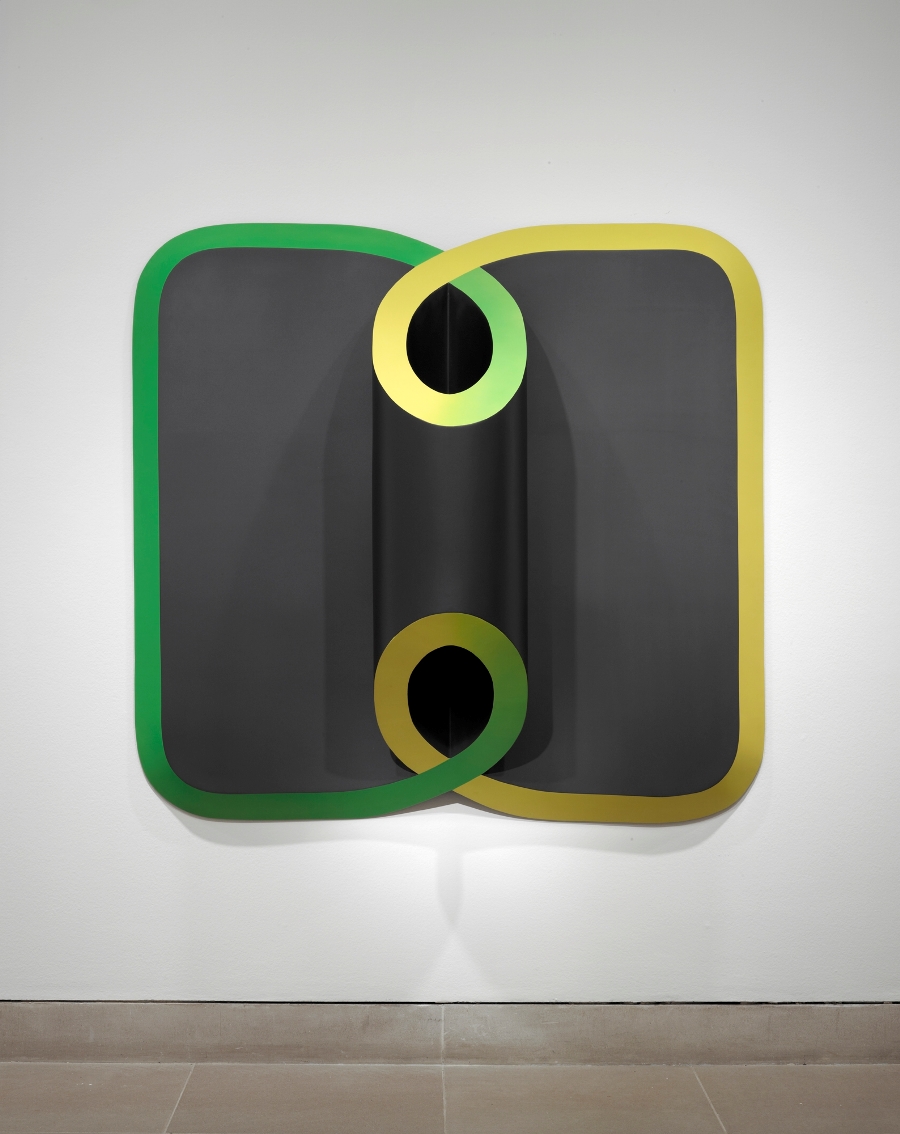
Phase No. 10, Nobuo Sekine, 1968, Steel, lacquer, and paint, The Rachofsky Collection and the Dallas Museum of Art through the DMA/amfAR Benefit Auction Fund
Sekine’s Phase-Mother Earth is closely related to the artist’s previous sculptures exploring the mathematical field of topology. Topology is a field of spatial geometry in which space and materials are considered malleable and can undergo countless transformations from one “phase” (state) to another without adding or subtracting from the original form/materials. In Sekine’s words, “a certain form can be transformed continually by methods such as twisting, stretching, condensing, until it is transformed into another.” This idea of manipulating form and space can be seen in Sekine’s work Phase No. 10 (1968) currently on view at the DMA. This wall-mounted sculpture closely resembles a Mobius strip, and when viewed head-on it appears to be a flat, curvilinear design, but when viewed at an angle the sculpture juts out from the wall, creating an optical illusion.
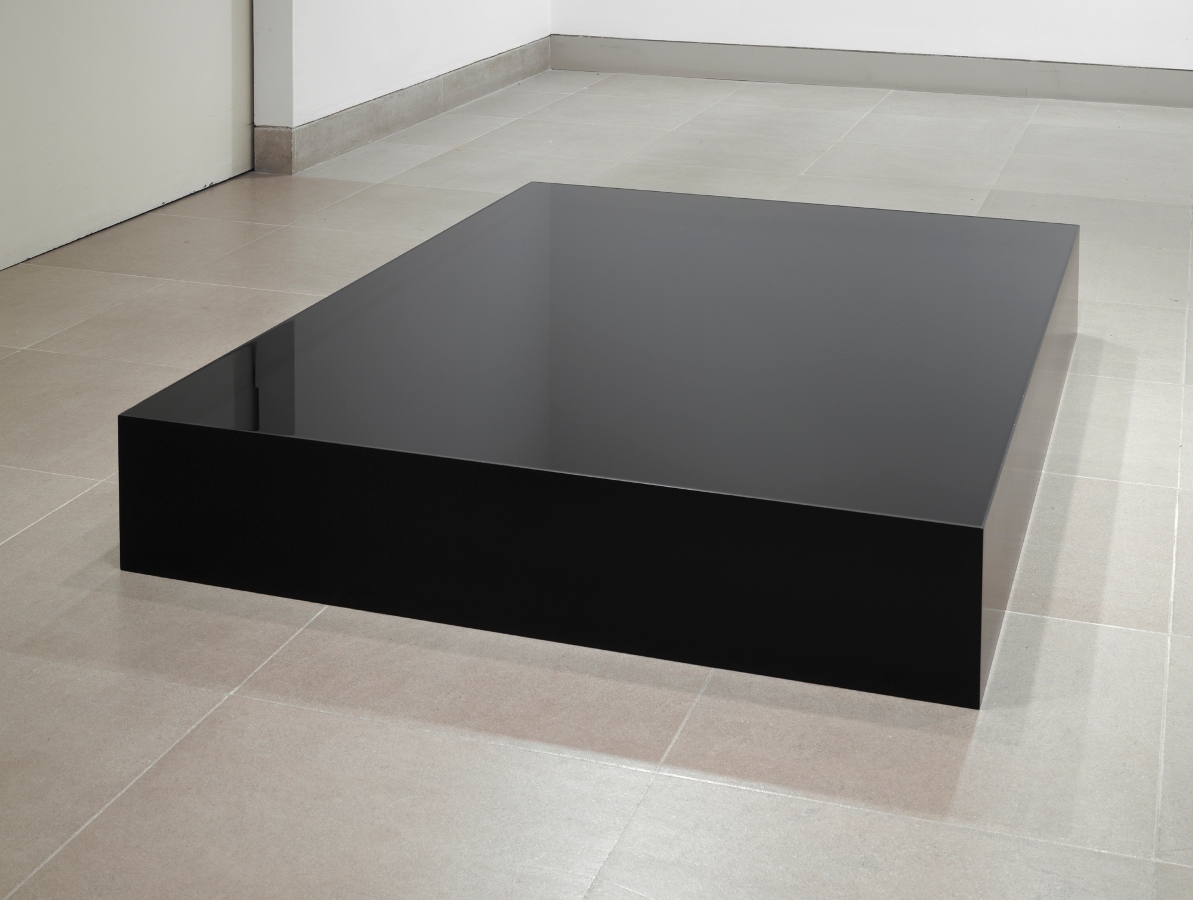
Phase of Nothingness—Water, Nobuo Sekine, 1969/2005, Steel, lacquer, and water, Dallas Museum of Art, DMA/amfAR Benefit Auction Fund
The work Phase of Nothingness—Water (1968) continues Sekine’s engagement with topology. To illustrate these ideas, the artist juxtaposed two equivalent shapes—a cylinder and a rectangle—both containing the same volume of water. At first glance, it doesn’t appear that the shallow rectangular tank and the tall cylindrical tank both hold the exact same amount of water. Similar to his earlier outdoor sculpture Phase—Mother Earth, this work attempts to depict a sense of equivalence and emphasizes the continuity of form and material. These two shapes are not meant to be seen as opposites but as equals. As Sekine explains, “[T]he mass of the universe neither increases nor decreases. This is the universe of eternal sameness. When one becomes aware of this, then the futility of modern concepts of creation can be realized.”
I hope this blog helps explain some of the fascinating (and at times complicated) ideas that inform Sekine’s sculpture. The exhibition closes Sunday, so plan your visit to the DMA before it’s too late!
Gabriel Ritter is The Nancy and Tim Hanley Assistant Curator of Contemporary Art at the Dallas Museum of Art.
Plumed Preview
Published August 1, 2012 Ancient Art , Curatorial , Education , Exhibitions , Members , Sculpture ClosedTags: ancient Mexican art, Dallas Museum of Art, member, Mexico, The Legacy of the Plumed Serpent in Ancient Mexico
DMA members are able to preview exhibitions before the official openings and this past week our members were able to get a sneak peek at the new exhibition The Legacy of the Plumed Serpent in Ancient Mexico. Below are a few photos from the preview days, be sure to visit the exhibition now through November 25.
Photography by Adam Gingrich, the Marketing Administrative Assistant at the Dallas Museum of Art
Seldom Scene: Scaled Down
Published July 25, 2012 Behind-the-Scenes , Contemporary Art , Curatorial , Exhibitions ClosedTags: Contemporary, Dallas Museum of Art
The new DMA exhibition Variations on Theme: Contemporary Art 1950s–Present explores themes and ideas that drive an artists’ creative process. With this concept in mind, the Contemporary Art Department thought it would be the perfect opportunity to share one way that curators tap into their own creative processes when developing a new exhibition – by using a scale model. Curators use scale models much like they would a doll house, to rationalize the gallery space in accordance with the placement of the art objects. Variations on Theme is installed in the gallery spaces known as the Barrel Vault and Quadrant Galleries, which are roughly 11,500 square feet. DMA carpenter Dennis Bishop constructed a wooden model of these galleries with a scale of 1:24 (one half-inch equals one foot). The objects in Variations on Theme are of various sizes and mediums and are complicated to install, so in order to visualize how certain works might look next to one another DMA exhibitions intern Jasmine Shevell created maquettes of each work that are proportional to the scale model of the exhibition space. Once each object is set into place, the design model is shared with our talented exhibitions team, registrar, and preparators, who bring the curator’s model to life!
Variations on Theme is on view at the Dallas Museum of Art until January 27, 2013.
Meg Smith is a Curatorial Administrative Assistant at the Dallas Museum of Art. Photography is by Adam Gingrich, the Marketing Administrative Assistant at the Dallas Museum of Art.
Seldom Scene: Load Three Tons and What Do You Get?
Published July 23, 2012 Ancient Art , Behind-the-Scenes , Dallas , Exhibitions , Installation 2 CommentsTags: Ancient Art, Dallas Museum of Art, Free, Mexico, The Legacy of the Plumed Serpent in Ancient Mexico, WFAA
We have been receiving and unpacking crates for a couple of weeks in preparation for the opening of The Legacy of the Plumed Serpent in Ancient Mexico on Sunday, July 29. This exhibition contains a number of works weighing hundreds of pounds, including a sculpture of sandaled feet weighing more than three tons, so we brought in some extra equipment and helping hands to assist in the installation process, which you can see below. Join us this Saturday, July 28, for a free sneak peek of the exhibition (normally $14) during the WFAA Family First Day from 11:00 a.m. until 5:00 p.m.
Photography by Adam Gingrich, Administrative Assistant for Marketing and Communications
Red, White, and Blue
Published July 4, 2012 American Art , Collections , Contemporary Art , Decorative Art and Design , European Art , Modern Art , Uncategorized 1 CommentTags: Anne Vallayer-Coster, Childe Hassam, Dallas Museum of Art, Fourth of July, James Brooks, Jean Antoine Theodore Giroust, Piet Mondrian, Rufino Tamayo, Wassily Kandinsky, Yves Tanguy
Some visitors to the DMA may have taken our self-guided tour Seeing Red, and loyal readers of our blog may remember a post we did back in December about works in our collection that are white. So while we have not focused on the color blue yet, we thought this would be a good day to share with you a few works in our collection that feature red, white, and blue.

Childe Hassam, Flags, Fifth Avenue, 1918, Watercolor, Dallas Museum of Art, Munger Fund, in memory of Mrs. George Aldredge

Anne Vallayer-Coster, Bouquet of Flowers in a Blue Porcelain Vase, 1776, Oil on canvas, Dallas Museum of Art, Foundation for the Arts Collection, Mrs. John B. O’Hara Fund and gift of Michael L. Rosenberg
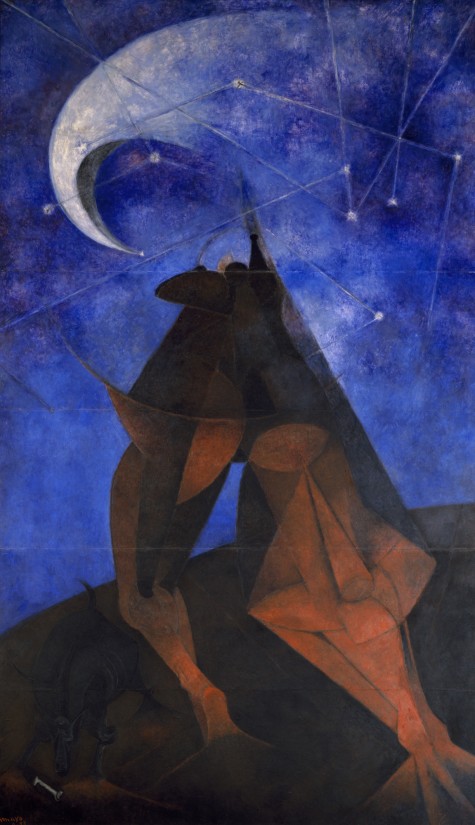
Rufino Tamayo, El Hombre (Man), 1953, Vinyl with pigment on panel, Dallas Museum of Art, Dallas Art Association commission, Neiman-Marcus Company Exposition Funds [credit line published in 1997 DMA Guide to the Collections: Dallas Museum of Art, commissioned by the Dallas Art Association through Neiman-Marcus Exposition Funds]

Piet Mondrian, Composition with Large Blue Plane, Red, Black, Yellow, and Gray, 1921, Oil on canvas, Dallas Museum of Art, Foundation for the Arts Collection, gift of Mrs. James H. Clark

Yves Tanguy, Apparitions, 1927, Oil on canvas, Dallas Museum of Art, The Eugene and Margaret McDermott Art Fund, Inc., in honor of Nancy O’Boyle

Jean Antoine Theodore Giroust, Oedipus at Colonus, 1788, Oil on canvas, Dallas Museum of Art, Foundation for the Arts Collection, Mrs. John B. O’Hara Fund

James Brooks, Quand, 1969, oil on canvas, Dallas Museum of Art, gift of the Meadows Foundation Incorporated

Wassily Kandinsky, Boating (from Sounds), 1907-1911, 1913, Volume with thirty-eight prose poems and twelve color and forty-four black-and-white woodcuts, Dallas Museum of Art, Centennial gift of Natalie H. (Schatzie) and George T. Lee
Stacey Lizotte is the Head of Adult Programming and Multimedia Services.
Let Your smARTphone Be Your Guide
Published July 2, 2012 Behind-the-Scenes , Collections , Curatorial ClosedTags: Dallas Museum of Art, smartphone tour, web-enabled
For many of us, our smartphones are an integral part of how we interact with and even interpret the world around us. At the DMA, we’ve been using smARTphone tours as a tool to do precisely that–allow visitors to become actively engaged with works of art throughout the Museum.
In 2009, when smartphones were first becoming popular, the DMA decided to experiment with creating tours for visitors on them. The Museum offers free Wi-Fi throughout the building, so we went with a web-based application that would work on any web-enabled smartphone. We gathered videos and audio clips, images, and text related to thirteen works of art in the collection and made them accessible to visitors via smartphones. There is so much fascinating information that can’t be displayed on labels and wall texts, and that first tour demonstrated the exciting possibilities offered by the interactive and multimedia features. Since then, we’ve created smARTphone tours for special exhibitions and added many stops to our collection tour.
Currently on the DMA’s smARTphone tour, you can listen to audio and video introductions for more than seventy-five works of art, learn about the artists and cultures that created them, check out community response projects like poems and sound designs, and look through archival and contextual photographs. Personally, some of my favorite choices include watching Dr. Heather MacDonald discuss why Claude Monet’s painting The Seine at Lavacourt was a failure, listening to sound designs created by UTD students in response to our Indonesian jaraik, and perusing the photographs of Coco Chanel at the Villa La Pausa.
While our initial efforts were well received, in 2011 the Museum embarked on a new phase of development of the smARTphone tours program. We revamped the design and organization, created a feature that allows multiple staff members to publish content, and added over fifty-five new stops to the tour.
From the interface design to the production of content, the DMA’s smARTphone tours are created entirely in-house and bring together staff from many of the Museum’s departments including IT, Education, Curatorial, and Marketing. While IT and Marketing worked on the new look of the tour, staff from the Education and Curatorial departments decided which works of art should be included and developed content. The new tour stops include over one hundred video and audio clips of curators speaking about works of art and artist biographies, and reflect the collaborative efforts of the various departments.
It was thrilling to see all of our hard work come to fruition when the new stops were released in February 2012 at the opening of the exhibition Face to Face: International Art at the DMA. The real highlight, though, is to see visitors using it. While conducting an evaluation of the smARTphone tour, I spoke with a mom and her twin 9-year-old boys, who said they had looked at every video in Face to Face and wanted to look at more when they got home!
Feedback from our visitors is especially important, and periodic evaluation has played an integral role in the development of the tours. From user experience to content, we’ve assessed visitor experiences with the smARTphone tours four times over the past several years. Each time we learn something new.
If you’re at the DMA or at home, be sure to check out the smARTphone tour at dma.mobi.
Laura Bruck is a museum consultant and also adjunct assistant professor of art history at the University of Dallas.
An Introduction by Way of Road Trip
Published June 25, 2012 Curatorial , Staff 2 CommentsTags: Dallas Museum of Art, Donald Judd, Elmgreen and Dragset, Marfa Texas, Prada Marfa, road trip, the Chinati Foundation
As the newest member of the DMA’s curatorial team, I thought I would take the opportunity to introduce myself to the online community. I am from Los Angeles and have been actively engaged with contemporary art in one way or another for the past ten years. While in Los Angeles, I worked as the director of Blum & Poe gallery and then as a Curatorial Assistant at the Museum of Contemporary Art, Los Angeles. Most recently, I’ve been working on my Ph.D. in art history at UCLA, and for the past year I was a Japan Foundation Doctoral Fellow, researching at the Museum of Modern Art, Tokyo. As the new Nancy and Tim Hanley Assistant Curator of Contemporary Art, I will be in charge of the ongoing Concentrations series, which organizes exhibitions of work by emerging and under-represented artists.
Being new to Texas, I thought a cross-country drive would be a great way to familiarize myself with my new surroundings. On our way from Los Angeles to Dallas, my wife and I decided to make a pilgrimage to the city of Marfa in West Texas, which the minimalist artist Donald Judd called home. As many of you know, the city houses both the Judd Foundation, which oversees the artist’s private estate, as well as the Chinati Foundation, which Judd founded as a contemporary art museum that presents large-scale, permanent public art installations by Judd and by artists Judd selected, including Carl Andrea, John Chamberlin, Dan Flavin, Roni Horn, Ilya Kabakov, and John Wesley, among others. For me, a highlight of our visit was the rare glimpse into Judd’s private life. Seeing his neatly organized studio spaces used for contemplation and his winter bedroom adorned with his collection of Native American jewelry and pottery was a treat. In addition, walking through Donald Judd’s untitled works in mill aluminum (1982-1986) was a transformative experience. Installed in two former artillery sheds, which Judd adapted specifically to house this installation, the work consists of one hundred unique sculptural iterations that utilize the same outer dimension of 41 x 51 x 72 inches. Natural light floods the two sprawling exhibition halls and reflects off the metallic volumes in a way that continues to change as you walk through the space.
The road to Marfa (and ultimately Dallas) took us through Phoenix, El Paso, Midland, and Abilene. On the way, we stopped by Elmgreen and Dragset’s roadside installation titled Prada Marfa (2005), which feels as if it dropped out of the sky. Literally in the middle of nowhere, with miles and miles of open road to either side, the installation mimics the Italian fashion brand’s posh boutiques but is in fact a nonfunctional storefront. At first we almost missed it and drove right past it, but then I quickly turned around so we could grab a shot of this mirage-like space on the highway. If you ever find yourself on I-90, stop by and check it out.
All-in-all it was a fun road trip and a great way to see the Texas countryside. We also enjoyed some great Tex Mex cuisine and even caught a concert at the local bar in Marfa. Now that I am settled in at the DMA, this will hopefully be the first of many blog posts focusing on contemporary art. I look forward to your comments, and I hope to meet you during your next visit to the Museum.
Gabriel Ritter is The Nancy and Tim Hanley Assistant Curator of Contemporary Art at the Dallas Museum of Art.
Pause and Remember
Published May 28, 2012 American Art , Curatorial ClosedTags: David Johnson, Garrison, Hudson River Valley, Memorial day, New York, United States Military Academy, West Point
Just in time for Memorial Day, the Dallas Museum of Art has added to its collection David Johnson’s 1870 painting View from Garrison, West Point, New York. This landscape is a fantastic panoramic view of the Hudson River Valley with the United States Military Academy at West Point front and center. As we take time off to celebrate the many sacrifices our veterans have made for our country, consider stopping by the Museum to see this painting, now on view in the American galleries.
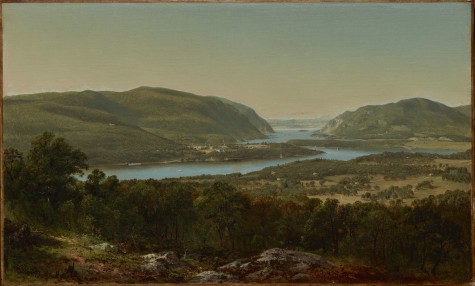
David Johnson, “View from Garrison, West Point, New York,” 1870, oil on canvas, Dallas Museum of Art, The Patsy Lacy Griffith Collection, gift of Patsy Lacy Griffith by exchange, and General Acquisitions Fund, 2012.6
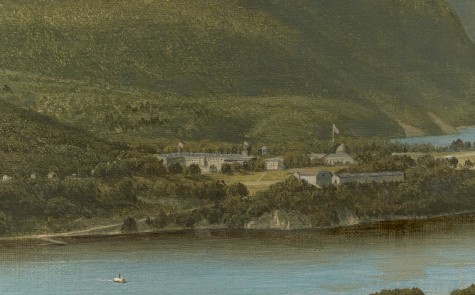
David Johnson, “View from Garrison, West Point, New York” (detail of United States Military Academy), 1870, oil on canvas, Dallas Museum of Art, The Patsy Lacy Griffith Collection, gift of Patsy Lacy Griffith by exchange, and General Acquisitions Fund, 2012.6
Martha MacLeod is the Curatorial Administrative Assistant in the European and American Art Department at the Dallas Museum of Art.
Picture This – Part Deux
Published May 25, 2012 Behind-the-Scenes , Collections , Curatorial , European Art 3 CommentsTags: conservation, Cornelis Saftleven, Dallas Museum of Art, frames, Seventeenth-century Dutch art
Over a year ago, the Dallas Museum of Art sent College of Animals by Cornelis Saftleven (1607-1681) to a conservator for cleaning and minor repair. With the grime removed from the Dutch artist’s enigmatic composition, it was the perfect time to do a bit more. So we replaced the thin, unadorned gilt frame that formerly surrounded the canvas with one more in keeping with the sort preferred by Dutch artists working during Saftleven’s time. Seventeenth-century Netherlandish artists typically favored a waffle or ripple style molding frame. These darkly painted wooden frames that simulated ebony are decorated with several rows carved in a zigzag design, and often have a reverse ogee profile. A few months ago, the DMA purchased a period Dutch frame that has all of these design elements from a Parisian dealer. Now that Saftleven’s College of Animals is back from the conservator and has an appropriate frame, it is once again on view in the European galleries for everyone to enjoy!
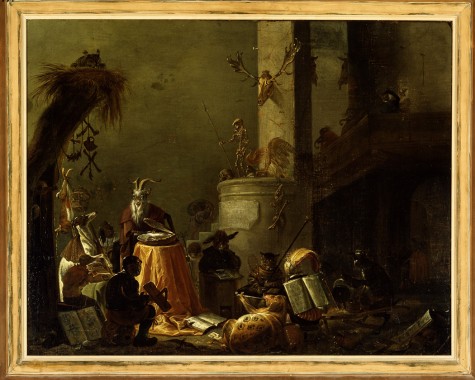
The simple gilt frame that formerly surrounded Cornelis Saftleven’s “College of Animals,” n.d., oil on canvas, Dallas Museum of Art, The Karl and Esther Hoblitzelle Collection, gift of the Hoblitzelle Foundation, 1987.32
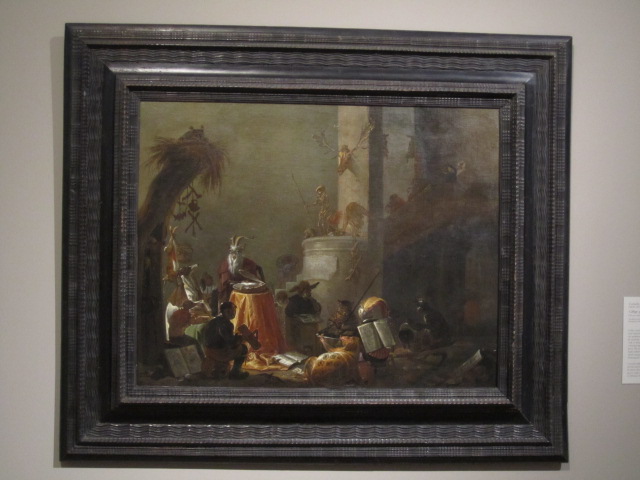
Cornelis Saftleven, College of Animals with its period seventeenth-century waffle-style Dutch frame.
Martha MacLeod is the Curatorial Administrative Assistant to the European and American Art departments.

